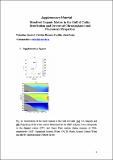Por favor, use este identificador para citar o enlazar a este item:
http://hdl.handle.net/10261/211056COMPARTIR / EXPORTAR:
 SHARE SHARE
 CORE
BASE CORE
BASE
|
|
| Visualizar otros formatos: MARC | Dublin Core | RDF | ORE | MODS | METS | DIDL | DATACITE | |

| Título: | Dissolved Organic Matter in the Gulf of Cadiz: Distribution and Drivers of Chromophoric and Fluorescent Properties |
Autor: | Amaral, Valentina; Romera-Castillo, Cristina CSIC ORCID ; Forja, Jesús M. | Palabras clave: | DOC DOM Optical properties PARAFAC Water mass analysis Biogeochemistry and coastal-ocean transitional system |
Fecha de publicación: | mar-2020 | Editor: | Frontiers Media | Citación: | Frontiers in Marine Science 7: 126 (2020) | Resumen: | The Gulf of Cádiz (GoC) connects the Mediterranean Sea with the Atlantic Ocean through the Strait of Gibraltar. Particular hydrographic processes take place in the GoC, such as riverine discharges and surface circulation marked by wind-induced seasonal upwelling. Although physical processes have been widely studied, little is known about the biogeochemical processes that occur in the basin, especially those involving organic matter. Therefore, vertical and seasonal dynamics of dissolved organic carbon (DOC) and optical properties of dissolved organic matter (DOM, absorbance and fluorescence) were measured in 766 samples collected between 5 and 800 m depth during four oceanographic cruises to obtain quantitative and qualitative information about DOM in the GoC. We performed parallel factor analysis (PARAFAC) to identify the main fluorophores present in the GoC, and an optimum multiparameter water mass analysis to differentiate the effect of water mass mixing from the biogeochemical processes in deep waters. PARAFAC analysis validated six fluorescent components; three humic-like, two protein-like, and a possible mixture of polycyclic aromatic hydrocarbon-like with protein-like material. DOC average concentration was 77.0 ± 12.7 μM, with higher values in surface and coastal waters during summer, mainly related to primary production. Linear relationships between DOC and apparent oxygen utilization indicate differences in oxygen consumption within the deep waters, which could be related to upwelling zones. Seasonal and spatial differences were also observed in the distribution of fluorescent DOM. Protein-like components were the most abundant fraction, with an average contribution of 64.75% ± 7.85%, being higher in summer and surface waters, associated with an increase in biological activity. Our results indicate that water mass mixing is the main driver of the major humic-like components, while biogeochemical processes at a local scale explain DOC and protein-like components distribution. Our findings suggest that modeling DOM dynamics in the GoC is complicated due to its complex hydrography and the presence of multiple sources and sinks of DOM | Descripción: | 15 pages, 5 figures, 3 tables, supplementary material https://doi.org/10.3389/fmars.2020.00126 | Versión del editor: | https://doi.org/10.3389/fmars.2020.00126 | URI: | http://hdl.handle.net/10261/211056 | DOI: | 10.3389/fmars.2020.00126 | Identificadores: | doi: 10.3389/fmars.2020.00126 e-issn: 2296-7745 |
| Aparece en las colecciones: | (ICM) Artículos |
Ficheros en este ítem:
| Fichero | Descripción | Tamaño | Formato | |
|---|---|---|---|---|
| Amaral_et_al_2020.pdf | 3,15 MB | Adobe PDF |  Visualizar/Abrir | |
| Amaral_et_al_2020_suppl.pdf | 4,64 MB | Adobe PDF |  Visualizar/Abrir |
CORE Recommender
SCOPUSTM
Citations
19
checked on 04-may-2024
WEB OF SCIENCETM
Citations
16
checked on 29-feb-2024
Page view(s)
144
checked on 04-may-2024
Download(s)
152
checked on 04-may-2024
Google ScholarTM
Check
Altmetric
Altmetric
NOTA: Los ítems de Digital.CSIC están protegidos por copyright, con todos los derechos reservados, a menos que se indique lo contrario.
